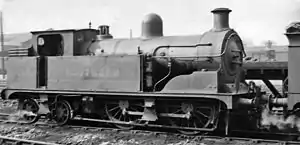LCDR R class
The LCDR R class was a class of 0-4-4T locomotives on the London, Chatham and Dover Railway (LCDR). No. 207 (eventually no. 31666) is notable as being the last former LCDR locomotive to be withdrawn from service.[1] The whole class was fitted with condensing apparatus for working on the Widened Lines.[2]
| LCDR R class | |||||||||||||||||||||||||||||||||
|---|---|---|---|---|---|---|---|---|---|---|---|---|---|---|---|---|---|---|---|---|---|---|---|---|---|---|---|---|---|---|---|---|---|
 No. 1675 at Tonbridge Locomotive Depot, 18 May 1946 | |||||||||||||||||||||||||||||||||
| |||||||||||||||||||||||||||||||||
| |||||||||||||||||||||||||||||||||
| |||||||||||||||||||||||||||||||||
History
For many years the London, Chatham and Dover Railway (LCDR) had favoured the 0-4-4T wheel arrangement for suburban and stopping passenger trains, and when more were required in 1890, consideration was given to ordering a further batch of the existing A2 class 0-4-4T (introduced 1883); it was then decided that a modified design was required.[3] The R class locomotives were designed by William Kirtley as a development of his earlier A2 class,[3] and 18 were built by Sharp, Stewart and Company in 1891.[4][5]
Numbering
Their LCDR numbers were 199–216, which under the South Eastern and Chatham Railway became 658–675 from 1899.[4] They were renumbered three more times: to A658–A675 by the Southern Railway (SR) from 1923; to 1658–1675 by the SR from 1931; and to 31658–31675 by British Railways from 1948.
Withdrawal
Three (Nos. 1664, 1668 and 1669) were withdrawn in 1940 to provides spares for the others,[1] and withdrawal of the rest occurred between 1949 and 1955.[5]
| Year | Quantity in service at start of year | Quantity withdrawn | Numbers |
|---|---|---|---|
| 1940 | 18 | 3 | 1664, 1668, 1669 |
| 1949 | 15 | 1 | 31672 |
| 1951 | 14 | 3 | 31659, 31667, 31670 |
| 1952 | 11 | 5 | 31658, 31665, 31673–31675 |
| 1953 | 6 | 3 | 31660, 31662, 31663 |
| 1954 | 3 | 1 | 31671 |
| 1955 | 2 | 2 | 31661, 31666 |
See also
Notes
- Bradley 1979, p. 87.
- Smith 1994, p. 25.
- Bradley 1979, pp. 82–83.
- Bradley 1979, p. 83.
- Bradley 1979, pp. 87–88.
- Bradley 1960, p. 33.
References
- Bradley, D.L. (March 1979) [1960]. The Locomotive History of the London, Chatham & Dover Railway (2nd ed.). London: RCTS. ISBN 0-901115-47-9.
- Bradley, D.L. (1960). The Locomotives of the London, Chatham & Dover Railway (1st ed.). London: RCTS.
- Smith, Martin (1994). Steam on the Underground. Ian Allan Publishing. ISBN 0-7110-2282-8.